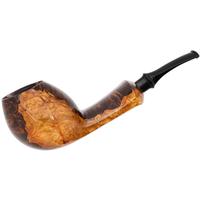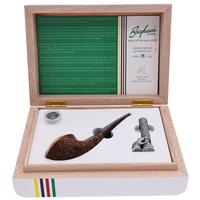You mentioned that it "felt" like a higher-quality item. Weight plays a roll in the perceived quality of a lighter. I've seen plastic-tank lighters with really thick outer bodies probably made from powdered metal matrix or something else cheap (but heavy), and I've also seen others with plastic tanks and metal weights filling internal dead space elsewhere in the lighter, in order to give it some heft in the palm. Some lighters have some plastic between the bottom metal plate and the tank, so hard to say what yours is. I would not worry about it, as I have found good lighters with plastic tanks, and crappy lighters with brass tanks. Like you said, if it ain't broke, don't fix it. Of course if it did break, I would probably try to fix it. =)
My Life in Butane Lighters
- Thread starter jpmcwjr
- Start date
You are using an out of date browser. It may not display this or other websites correctly.
You should upgrade or use an alternative browser.
You should upgrade or use an alternative browser.
- Status
- Not open for further replies.
A Rollagas 'tank' is the body of the lighter (don't ask how I know, ok, I 'fixed' it). I seem to recall reading that the Kiribi is the same, which would lead me to believe a Old boy is as well. I would guess all of the top quality lighters are similar in that regard.
I also have a old Ronson made in USA Varaflame that is a 'tank body'...but it's spark wheel mechanism is worn so badly I guess I'll have to try to 'fix' it one of these days.
I also have a old Ronson made in USA Varaflame that is a 'tank body'...but it's spark wheel mechanism is worn so badly I guess I'll have to try to 'fix' it one of these days.
The Pete Old Boys and all of the I.M. Corona lighters that I have seen have stamped brass tanks with separate outer sleeves. It looks like the Dunhill Unique Old Boys are monoblock. I tore down a beat-up Varaflame to see how it went together, and the valve area was a pain to work on. Rollagas looks like a pain to work on, too. =)
I own a Kiribi Mikazuki. Love the lighter, but sorry noob that I am I've yet to find a way to use it effectively (as in not burning my mouth when lighting).
I recently got a Zippo for pipes, which I finally used yesterday with my Eaton cob.
Question on Zippos: is there a technique to light your pipe without getting fuel taste? I probably used it twice to light/relight my pipe and one time I got a mouthful of fuel. Yuckers!
I got a multipack (500) of strike-anywhere matches at the Canadian Tire: yep, they were in the camping section. Red Bird matches. Best of the deal: no 'smoking kills' warnings on the boxes.
I recently got a Zippo for pipes, which I finally used yesterday with my Eaton cob.
Question on Zippos: is there a technique to light your pipe without getting fuel taste? I probably used it twice to light/relight my pipe and one time I got a mouthful of fuel. Yuckers!
I got a multipack (500) of strike-anywhere matches at the Canadian Tire: yep, they were in the camping section. Red Bird matches. Best of the deal: no 'smoking kills' warnings on the boxes.
Hold the flame further away from the tobacco. You want to use the minimum BTUs to ignite your bowl so as not to torch the tobacco.
I got caught up in Cup O Joes 25 percent off sale and had to buy these 2 lighters. Both are IM Corona but I forget the names on them.




Hold the flame further away from the tobacco. You want to use the minimum BTUs to ignite your bowl so as not to torch the tobacco.
Couple of stupid question there:
- Do you mean that if I apply the blue of the flame I'd torch the baccy?[/*]
- When I hold the flame from whichever source away from the bowl, upon puffing the yellow part of the flame comes down and touches the toby and ignites it. I'm guessing this is the right procedure. Question is: Isn't the yellow portion the hottest part of the flame?[/*]
- Kiribi: ~750 °C (1382 °F)[/*]
- Zippo: ~530 °C (986 °F)[/*]
- Match: ~450 °C (842 °F)[/*]
@Harris , I was also looking at those as well. The IM Corona PipeMaster line.
@olkofri - On the Zippo question , I have found that when you ignite , make sure to wait a few seconds before using.
It is more important to handle the false light correctly - I usually do two false lights before the true light -
@olkofri - On the Zippo question , I have found that when you ignite , make sure to wait a few seconds before using.
It is more important to handle the false light correctly - I usually do two false lights before the true light -
False light is the term used to describe the technique of placing just enough fire over the pipe tobacco to create a light layer of ash that acts acts as a blanket of insulation. When there's insulation over your pipe tobacco, it will burn for a longer period of time; thus, eliminating the need for relighting it each time you want to take a puff.
To perform a false light, you should hold the flame (whether it's a match of lighter) over the pipe tobacco and slowly move it in a circular motion. Holding the flame in one area for too long will burn your pipe tobacco, which is something you don't want to happen. The idea is to keep the flame moving at a slow but steady speed so the heat only burns the top of the tobacco.
After performing a false light on your pipe tobacco, you should use a tamper to pat down the top layer of tobacco. The trick is to pat it down with just enough force to create a kind of ash layer on top.
You might be wondering what the purpose of a false light is. After all, can't you just skip the false light and go straight to the real light? Well, you could, but taking the time to perform a false light beforehand will help keep your pipe lit. There's nothing more frustrating than constantly lighting your pipe each time you want to take a hit, but thankfully this is something that can be prevented by performing a false light.
Learning how to perform an effective false light without destroying your tobacco is something that takes time, patience and practice (lots of it). Don't get discouraged if your flame goes out or if your tobacco burns. Keep trying and you will eventually learn to create a false light. Once you've found the "happy medium" where the flame burns just enough of the tobacco without going all the way through, you can perform a false light anytime, anywhere.
I've looked at the Double Corona as well, and noticed that it's a cigar lighter with a two jet flame. I really don't know if that is a deal breaker, but it does concern me.
I can't say if the two jet flame doesn't work for a pipe, I've never tried.
All the IM Coronas are very good lighters, the Double looks to be a Dupont 'knockoff'...
you could get a side flame jet on a Dupont ya know, only for three times or more the price.
Honestly, I think the law of diminishing returns applies to lighters...but I'm of Scots heritage.
I can't say if the two jet flame doesn't work for a pipe, I've never tried.
All the IM Coronas are very good lighters, the Double looks to be a Dupont 'knockoff'...
you could get a side flame jet on a Dupont ya know, only for three times or more the price.
Honestly, I think the law of diminishing returns applies to lighters...but I'm of Scots heritage.
Missed some posts here a while ago- As to the flame and BTU's: Makes little difference what the temp is, as that's easily regulated by the distance the tip of the flame is held from the top of the tobacco. Somewhere between a quarter and 3/4 inch should do it depending on the temp and dryness of the tobacco.
Flame directors can be counter productive, as you want to draw the heat to the tobacco, not blast it. That said, I sometimes grab my torch butane lighter for relights. Less than a second seems to give a good relight without damaging the briar.
Flame directors can be counter productive, as you want to draw the heat to the tobacco, not blast it. That said, I sometimes grab my torch butane lighter for relights. Less than a second seems to give a good relight without damaging the briar.
IIRC, the yellow part is not the hottest. But in any event, it's the superheated air off the tip that gives good ignition. But even if the hottest part of the flame goes directly onto the tobacco, all is not lost: time in contact is major. A few parts of a second may be fine.Couple of stupid question there:
Do you mean that if I apply the blue of the flame I'd torch the baccy?
When I hold the flame from whichever source away from the bowl, upon puffing the yellow part of the flame comes down and touches the toby and ignites it. I'm guessing this is the right procedure. Question is: Isn't the yellow portion the hottest part of the flame?
And there's no need for a charring light. It's very optional some (or most) of the time, and not so on other first lights. Doing it every time it's a ritual- and a fine one.
Written before the into. of those good Chinese ST DuPont tributes.... I love mine, and have ordered a couple more.I have a lot of lighters. The IM Corona Old Boy (style copied from the Dunhill Unique series) is by far the best engineered and most durable of all of them. Superior gas regulation, excellent construction, thick chrome...just a great lighter.
I have 2 Im Corona old boy lighters and i think i need a third one, just becouse they are awesome :D
You guys are costing me a lot of money
Who cares about money? What if you die tomorrow? Just buy everything you want and do it now :mrgreen:
Yeah,Never tried or never wanted to try a Zippo for my pipe smoking.I went through a lot of lighters that failed.I decided to buy re-fillable butane cheap lighters...mossy oak ones with camo pictures.I bought about 15 on ebay and I have only had to toss 1 in about 3 years. They refill real easy also.Best thing is you can remove the logo to have a clear lighter to see how much fluid is left.I have been lazy and just keep the logo on and take 2 with me. 8O
- Status
- Not open for further replies.












